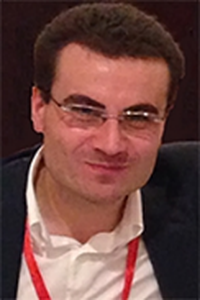Contatto di riferimento: Prof. Gianni Pasolini
Recapito telefonico per contatti: + 39 051 2093553
About the speaker
Marco DI RENZO was born in L'Aquila, Italy, in 1978. He received the Laurea (cum laude) and Ph.D. degrees in electrical engineering from the University of L'Aquila, Italy, in 2003 and 2007, respectively, and the Habilitation à Diriger des Recherches (Doctor of Science) degree from University Paris-Sud, France, in 2013. Since 2010, he has been a Chargé de Recherche CNRS (CNRS Associate Professor) in the Laboratory of Signals and Systems (L2S) of Paris-Saclay University - CNRS, CentraleSupélec, Univ Paris Sud, Paris, France. He serves as the Associate Editor-in-Chief of IEEE Communications Letters, and as an Editor of IEEE Transactions on Communications, and IEEE Transactions on Wireless Communications.
He is a Distinguished Lecturer of the IEEE Vehicular Technology Society and IEEE Communications Society, and a Senior Member of the IEEE. He is a recipient of several awards, including the 2013 IEEE-COMSOC Best Young Researcher Award for Europe, Middle East and Africa, the 2013 NoE-NEWCOM# Best Paper Award, the 2014-2015 Royal Academy of Engineering Distinguished Visiting Fellowship, the 2015 IEEE Jack Neubauer Memorial Best System Paper Award, the 2015-2018 CNRS Award for Excellence in Research and Ph.D. Supervision, the 2016 MSCA Global Fellowship (declined), the 2017 SEE-IEEE Alain Glavieux Award, the 2018 IEEE ICNC Silver Contribution Award, and 6 Best Paper Awards at IEEE conferences (2012 and 2014 IEEE CAMAD, 2013 IEEE VTC-Fall, 2014 IEEE ATC, 2015 IEEE ComManTel, 2017 IEEE SigTelCom).
Abstract
In this talk, we introduce and discuss a new methodology for the analysis and optimization of cellular networks. In particular, we focus our attention on the energy efficiency of downlink cellular networks. With the aid of tools from stochastic geometry, we introduce a new closed-form analytical expression of the potential spectral efficiency (bit/sec/m2). In the interference-limited regime for data transmission, unlike currently available mathematical frameworks, the proposed analytical formulation depends on the transmit power and deployment density of the base stations. This is obtained by generalizing the definition of coverage probability and by accounting for the sensitivity of the receiver not only during the decoding of information data, but during the cell association phase as well.
Based on the new formulation of the potential spectral efficiency, the energy efficiency (bit/Joule) is given in a tractable closed-form formula. An optimization problem is formulated and is comprehensively studied. It is mathematically proved, in particular, that the energy efficiency is a unimodal and strictly pseudo-concave function in the transmit power, given the density of the base stations, and in the density of the base stations, given the transmit power. Under these assumptions, therefore, a unique transmit power and density of the base stations exist, which maximize the energy efficiency. Numerical results are illustrated in order to confirm the obtained findings and to prove the usefulness of the proposed framework for optimizing the network planning and deployment of cellular networks from the energy efficiency standpoint.
